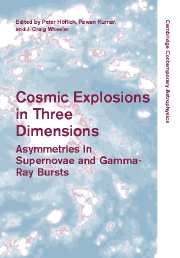Book contents
- Frontmatter
- Contents
- Part I Introduction
- Part II Supernovae: Observations Today
- Part III Theory of Thermonuclear Supernovae
- Part IV Theory of Core Collapse Supernovae
- 22 Rotation in core collapse progenitors: single and binary stars
- 23 Large scale convection and the convective supernova mechanism
- 24 Topics in core-collapse supernova-theory
- 25 MHD supernova jets: the missing link
- 26 Effects of super-strong magnetic fields in a core collapse supenova
- 27 Non-radial instability of stalled accretion shocks: advective-acoustic cycle
- 28 Asymmetry effects in hypernovae
- 29 Stellar abundances: the r-process and supernovae
- Part V Magnetars, N-Stars, Pulsars
- Part VI Gamma-ray Bursts
- Part VII Conference Summary
- References
24 - Topics in core-collapse supernova-theory
Published online by Cambridge University Press: 11 August 2009
- Frontmatter
- Contents
- Part I Introduction
- Part II Supernovae: Observations Today
- Part III Theory of Thermonuclear Supernovae
- Part IV Theory of Core Collapse Supernovae
- 22 Rotation in core collapse progenitors: single and binary stars
- 23 Large scale convection and the convective supernova mechanism
- 24 Topics in core-collapse supernova-theory
- 25 MHD supernova jets: the missing link
- 26 Effects of super-strong magnetic fields in a core collapse supenova
- 27 Non-radial instability of stalled accretion shocks: advective-acoustic cycle
- 28 Asymmetry effects in hypernovae
- 29 Stellar abundances: the r-process and supernovae
- Part V Magnetars, N-Stars, Pulsars
- Part VI Gamma-ray Bursts
- Part VII Conference Summary
- References
Summary
Abstract
There are many interesting topics at the intersection of physics and astrophysics we call Supernova Theory. A small subset of them include the origin of pulsar kicks, gravitational radiation signatures of core bounce, and the possible roles of neutrinos and rotation in the mechanism of explosion. In this brief communication we summarize various recent ideas and calculations that bear on these themes.
What is the mechanism of pulsar kicks?
Radio pulsars are observed to have large proper motions that average ∼400–500 km s-1 (Lyne & Lorimer 1994) and whose velocity distribution might be bimodal (Fryer, Burrows, and Benz 1998; Arzomanian, Chernoff, & Cordes 2002). If bimodal, the slow peak would have a mean speed near ∼100 km s-1 and the fast peak would have a mean speed near 500–600 km s-1. A bimodal distribution implies different populations and different mechanisms, but what these populations could be remains highly speculative.
Many arguments suggest that pulsars are given “kicks” at birth (Lai 2000; Lai, Chernoff, and Cordes 2001), and are not accelerated over periods of years or centuries. The best explanation is that these kicks are imparted during the supernova explosion itself. We think that this view is compelling. The two suggested modes of acceleration and impulse are via net neutrino anisotropy during the neutrino emission phase (which lasts seconds) and anisotropic mass motions and aspherical explosion which impart momentum to the residual core.
Information
- Type
- Chapter
- Information
- Cosmic Explosions in Three DimensionsAsymmetries in Supernovae and Gamma-Ray Bursts, pp. 209 - 218Publisher: Cambridge University PressPrint publication year: 2004
References
Accessibility standard: Unknown
Why this information is here
This section outlines the accessibility features of this content - including support for screen readers, full keyboard navigation and high-contrast display options. This may not be relevant for you.Accessibility Information
- 6
- Cited by
